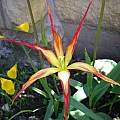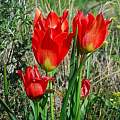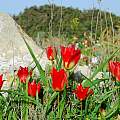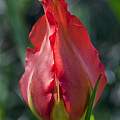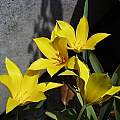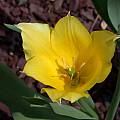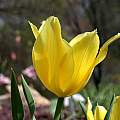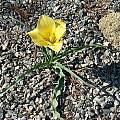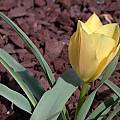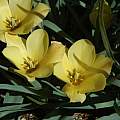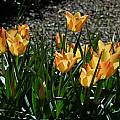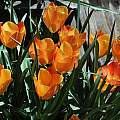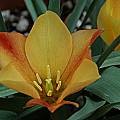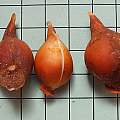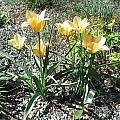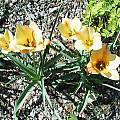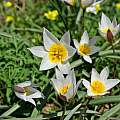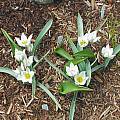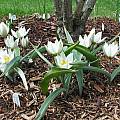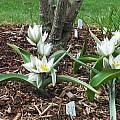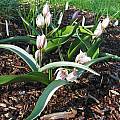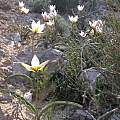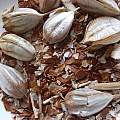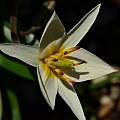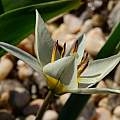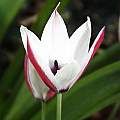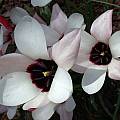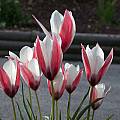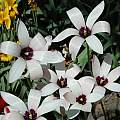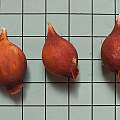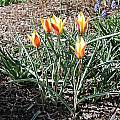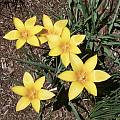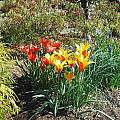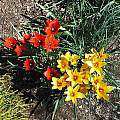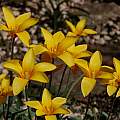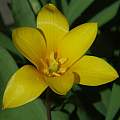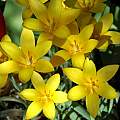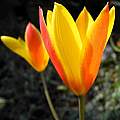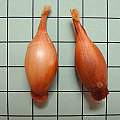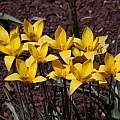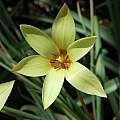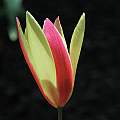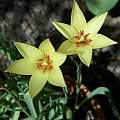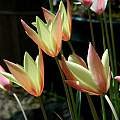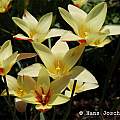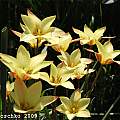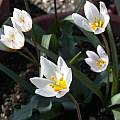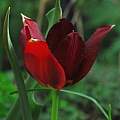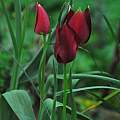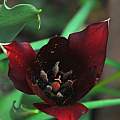Tulipa is a genus in the Liliaceae family from Europe, western Asia to central Asia, and North Africa. There are about 100 species and thousands of cultivars. A book written in 2006 by Richard Wilford is a good source of information. Tulipa species a-c are found on this page.
Tulipa Hybrids - Tulipa d-h - Tulipa i-r - Tulipa s-z - Tulipa index
Tulipa acuminata Vahl ex Hornem. is known as the horned tulip and has narrow pointed red streaked with yellow petals. Wilford believes it to be a hybrid originating from Turkey. Growing from 40 to 50 cm tall with a solitary flower it is often offered in the trade. The Plant List regarded it as a synonym for T. gesneriana L., but Plants of the World Online considers it one of the many synonyms of Tulipa agenensis. The first photo from Arnold Trachtenberg shows it flowering in late spring and growing in New Jersey. Second photo by Martin Bohnet, Zone 7 in southern Germany.
Tulipa agenensis Redouté is a widespread species from the Eastern Mediterranean to Jordan. Flowers are crimson red, with a yellow patch on the outside. Leaves are variable, either undulate or erect. It grows in different habitats from sea-level to about 2000 m. Photos 1 and 2 were taken by Oron Peri in the Mediterranean coastal area in North Israel. Photos 3 and 4 were taken by Shlomit Heymann in the Carmel mountains, late March 2011, the first winter after a fire.
Tulipa agenensis subsp. sharonensis (Dinsm.) Feinbrun is found on coastal buffs in Israel. Photo by Gideon Pisanty.
Tulipa altaica Pall. ex Spreng. from Central Asia has deep yellow flowers that are cup-shaped with pointed tepals. It has received the RHS award of Garden Merit. Plants grown in New Jersey and photographed by Arnold Trachtenberg.
Tulipa armena Boiss. is a species from Central Asia (NE. Turkey to NW. Iran) where it grows on rocky slopes and screes. Growing from 10 to 25 cm, it has a bulb tunic with a thick layer of long hairs. The usual form is red with a dark basal blotch, but there are also yellow forms in Turkey. Many named species are now included as synonyms, including Tulipa confusa Gabrieljan, Tulipa galatica Freyn, Tulipa gumusanica Terzioglu, Tulipa karabachensis Grossh., Tulipa lutea Freyn, Tulipa mucronata Fomin, and Tulipa willmottiae Freyn. Photos below from John Lonsdale of plants grown as Tulipa karabachensis Grossh.
Tulipa aucheriana Baker see Tulipa humilis var. aucheriana (Baker) Christenh
Tulipa bakeri A.D.Hall see Tulipa saxatilis Sieber ex Spreng.
Tulipa batalinii Regel is a native of Soviet Central Asia where it grows on stony hillsides. It is considered by Brian Mathew and Plants of the World Online to be a synonym of Tulipa linifolia Regel with yellow flowers instead of red. It is sometimes labeled Tulipa linifolia Batalinii group and the whole group has received the RHS award of garden merit. It is still sold as Tulipa batalinii. It is one of the best small tulips for the rock garden, available in several named forms. I like the strongly undulate leaves. Text and first photo by Mark McDonough and the second photo by John Lonsdale. The third photo from Mary Sue Ittner. Tulipa batalinii 'Bright Gem' received the RHS award of garden merit.
This species has returned year after year for me in Northern California. I store it dry during our long dry dormancy and then chill for 4-6 weeks before planting in December. It stands up to rain better than some since it isn't so tall. Photos by Mary Sue Ittner. The first three show it back lit and blooming April 2006. The last shows the bulbs on a 1 cm grid.
Tulipa batalinii 'Bronze Charm' is one of several lovely named forms. This one has soft yellow flowers slightly kissed with bronze-orange. Photos by Mark McDonough.
Tulipa biflora Pall. has a range from Macedonia to southwestern Russia and south through the Caucasus Mountains into eastern Turkey, Iran, Turkmenistan, Afghanistan, Pakistan, and China. Growing to about 10 cm, it has bulb tunics densely lined with hairs inside. It is an early flowering species with starry white 1 to 3 or more flowers with a golden yellow basal blotch tinged on the outside with a greenish or purplish suffusion. It grows on grassy or rocky slopes and screes. Photo taken in the Astrakhan Reserve, Russia, May 2017 and taken from Wikimedia Commons and displayed under a CC BY-SA 4.0 license.
Another named species, Tulipa polychroma Stapf is considered by most authorities to be a synonym of Tulipa biflora Pall. It was found in Iran and Afghanistan. Mark McDonough supplied the first four photos and wrote this about it: "It is an excellent miniature species for the rock garden, with charming white "star cups" on 2-3" (5-7.5 cm) stems. The center of the flower is yolk yellow, but it's the outside of the flowers that give this species its character. The back of the outer 3 tepals are tinged matte olive-mauve, and the back of the 3 inner tepals are lightly striped with green and blue. The flowers are deliciously scented. The first three views show the flowers from above and the side to illustrate the outer tepal markings and the last at late anthesis, the outer tepals age to a pale ruddy rose color." The fifth photo is of wild plants taken by Gideon Pisanty. The last photo is a seed and seed pod photo by Ina Crossley.
Tulipa bifloriformis Vved. grows wild on stony slopes in the foothills of the Tien Shan, where it can flower March to July. The photos were taken by Arnold Trachtenberg.
Tulipa clusiana Redouté is known as the Lady Tulip. This species is from Iran east to the western Himalaya. It is one of the few species that can naturalize in Mediterranean climates that do not have cold winters. The basic flower color is white (although there are forms of various shades of yellow) with the three outer tepals red with a pink band on the back. Inside the flower is a small purple blotch at the base of the tepals. The flowers are attractive when closed and when the sun shines the flowers open wide. This tulip grows from 13 to 30 cm. Bulbs have a tough tunic with a few hairs around the base and longer hairs at the neck, forming a thick felt that protrudes from the top of the base. The white form is not offered as often as some of the yellow forms. Photo 1 was taken by Arnold Trachtenberg, photos 2-3 by John Lonsdale, photo 4 by Mary Sue Ittner, and photo 5 by Hans Joschko of the cultivar 'Lady Jane', a recipient of the RHS award of garden merit. The last photo from Mary Sue Ittner shows the bulbs on a 1 cm grid.
Tulipa clusiana var. chrysantha (A.D.Hall) Sealy shown in the first two photos was purchased as Tulipa chrysantha Boiss. Most databases are no longer recognizing this form as deserving variety status. It has however received the RHS award of garden merit (as var. chrysantha). This form of Tulipa clusiana originally was sold as a yellow form of Tulipa montana. It is a nice small tulip for the rock garden. The flowers only open after an hour or more of bright light, and are truly striking when stretched wide and flat to greet the sun, the inside showing none of the red coloration evident on the outside of the flower. The first photo shows the plant at early anthesis with the strong red color on the exterior of the outer tepals. Tulipa linifolia can be seen behind the featured tulip, the buds just showing at the base. Buds and the undulate leaves of Tulipa linifolia can be seen in the upper right behind the featured tulip in the second photo. Photos 3-4 are views of Tulipa clusiana var. chrysantha flowering along with the brilliant red Tulipa linifolia taken on May 10, 2003. The red backs to the bright yellow Tulipa clusiana var. chrysantha show well here. Both need a couple of hours of full sun to open. Photos 1-4 by Mark McDonough. The fifth photo was taken by Hans Joschko.
Photos below of bulbs received as Tulipa chrysantha and another species (wrongly named) that resemble photos on the Internet of tulips named Tulipa clusiana var. chrysantha 'Tubergen's Gem' or sometimes just Tulipa 'Tubergen's Gem' (clusiana group). 'Tubergen's Gem' is a tall form that has large yellow flowers with a bold red band on the back of the outer tepals. The last photo from Mary Sue Ittner shows the bulbs on a 1 cm grid.
'Cynthia' was introduced in 1959 by Van Tubergen. It grows to 25 cm and has narrow, grey-green leaves and has received the RHS award of garden merit. The solitary flowers are pale yellow; the outer tepals are rose-red edged with pale yellow on the outside, pale yellow within. The first photo was taken by John Lonsdale. The rest of the photos by Mary Sue Ittner are of plants received as Tulipa clusiana that are obviously a cultivar and might be this one.
Below are some of the other yellow forms often sold as Tulipa clusiana. 'Honky Tonk' has soft, pale yellow flowers with a slight pinkish staining towards the tip of the outer tepals. 'Tinka' is primrose-yellow with a cardinal-red back and dark purple pollen. 'Sheila' is similar with a darker yellow base to the tepals and yellow pollen. Photos by Hans Joschko.
Tulipa cretica Boiss. & Heldr. comes from Crete and thus is one of the more southern and western species. It grows between rocks and stones on open slopes, cliffs, and screes, at altitudes of 500 to 2200 m (1640 to 7200 ft) in mountains and gorges. The photo shows the typical pinkish color. It was grown from seed purchased from Jim & Jenny Archibald. Photographed by Jane McGary in a bulb frame in Oregon, flowering in late March.
Tulipa cypria Stapf ex Turrill is a rare species, endemic to Cyprus where it grows at low elevations mainly in the northern part of the island. It is closely related to Tulipa agenensis but is easily recognised by the color of the flowers which are a deep blood color, making this species the darkest of all tulips. Photos taken by Oron Peri in his collection.
Tulipa Hybrids - Tulipa d-h - Tulipa i-r - Tulipa s-z - Tulipa index

